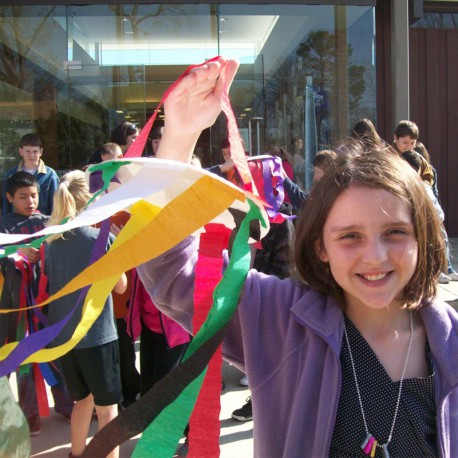 View larger
View larger
Wind Streamer
New activity
Children create a wind streamer out of common materials and use it to determine the wind’s direction.
Open Activity
How-to Video
Teacher's Guide
Provides classroom connections, key concepts, connections to science standards, and additional resources.
-
Rating
-
Participants Enjoyed the ActivityParticipants Learned from This ActivityActivity Instructions Were Clear and Easy to FollowWould Recommend
Related Programming Resources
Reviews
Easy Program for PreK crowd!
Our demographic trends very young, with older siblings tagging along to attend programming. I’m always looking for STEM programming for tots and early elementary aged children, but it has to engage their siblings as well. I used this program with a Wind & Kites themed storytime – and it was a hit! We had most of the materials on hand, and since this program was geared to younger children I just prepped and precut the material ahead of time, and had the older children work on their own. I always make a sample of whatever I make; the families don’t like looking at videos or pictures of samples. I discussed the science behind the activity while we were working, and printed out some information for parents to take pictures of. They typically don’t take handout, but they will take pictures of everything for home reference.
A fun, easy, clearly-described activity.
As with all of the activities in the STAR_net Activity Clearinghouse that we’ve used that were designed and written by the STAR_net program staff (i.e. were not linked to from outside sources), this is a beautifully designed and easy-to-execute program rich with resources and instructional materials. There is a detailed Activity Guide and a separate Teacher’s Guide (for “Earth Science Programming”), both of which work together to generate enough material to run an entire summer around these crafts. Maybe that’s a *touch* of an exaggeration, but suffice it to say: STAR_net goes the extra mile in activity-planning, and it shows on activities like this one. I certainly didn’t emerge from planning the wind streamer activity with any lack of direction! If anything, we ran out of time to ask all of the recommended questions and take advantage of all of the ancillary materials.
My general takeaway from this activity is that it does require a little bit of planning to execute, but that it’s also relatively easy to scale from one age group to another, and one time frame to another, and one set of resources to another. It’s adaptable, is what I mean. We utilized it during our Solar Eclipse Block Party, in which we had lots of uncontrolled variables (weather, materials, number and attention spans of participants) and it worked just fine. We utilized it during our weather-themed Story Time, in tandem with the Cloud Teller craft (http://clearinghouse.starnetlibraries.org/earth-science/134-cloudteller.html), with really young kids with short attention spans, and it worked just fine there as well. (The only allowance we made was pre-cutting and portioning some of the materials.) We utilized the leftover materials in our Monday Makerspace, which attracts mostly older, school-aged children. The result was a shocker: it worked great there too! So really, with a touch of modification this works in any number of settings.
Just remember not to rely on the “how-to” video if you use Google Chrome; it doesn’t like our browsers here at our library much at all. A much more reliable technology is simply to build your own wind streamer ahead of time and to pass that around. Kids like handling the model, anyway.
This would be a great pairing with the “Wind Turbine Tech Challenge” (http://clearinghouse.starnetlibraries.org/engineering/37-wind-turbine-tech-challenge.html) if you have the time!
Quick and easy activity
I used this activity as one of three for a library event called “The Power of Wind.” The program was targeted for kids in grades K-6 and their caregivers were invited to stay. The other two activities I did during this event were “Can a Toaster Make Wind?” and “Puff Mobiles.” This was our final activity of the program, so the kids could take their streamers outside right away and try them out on their way home.
Because we had already discussed wind and wind power in the first two activities, we got right to work for this one. I provided paper plates, hole punches, scissors, rolled crepe paper, tape, and markers, as well as the pre-printed Wind Streamer Graphic and instructions. I had made a sample of this activity for the kids to see before they started.
The kids had fun picking the colors and measuring the cutting their streamers. Most colored their paper plates to match. We found that taping the streamers after they were threaded through the plate was more secure than tying them. Caregivers were in the room and many of them had a compass on their smart phone, so as the kids left the event they were able to determine which direction the wind was blowing with their new Wind Streamers.



